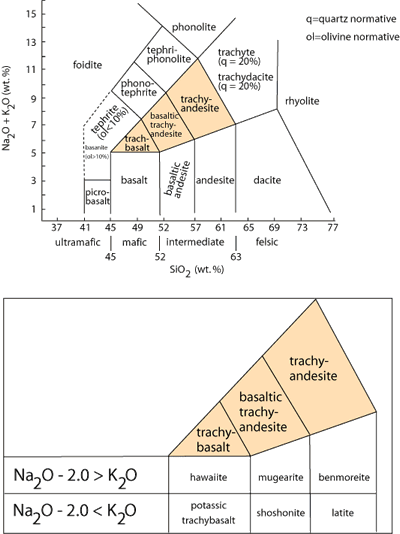
The Naming of Volcanic Rocks
Volcanic rocks are fine-grained igneous rocks that are erupted at the Earth's surface. Many of us learn a simple classification scheme for volcanic rocks in Geology 101. This classification scheme is based on the relative amounts of silica, iron, and magnesium in volcanic rocks. Rhyolite is a volcanic rock that contains abundant silica, but little iron and magnesium; small crystals (phenocrysts) of quartz and feldspar can be observed in rhyolite with a hand lens. Rhyolite is often white to tan to pink in color, but when it is glassy, it can be black. Rhyolite is a sticky or viscous lava that usually does not flow very far from the place where it is erupted. In contrast, basalt is a volcanic rock that contains relatively little silica and abundant iron and magnesium, so phenocrysts of olivine and pyroxene are common. Basalt is usually black to dark brown in color. Basalt has a low viscosity, and as a result basalt flows long distances away from the eruption source. Andesite and dacite are intermediate in composition and viscosity between rhyolite and basalt. Dacite is characterized by the presence of phenocrysts of biotite and hornblende.
Geologists have developed more detailed classification schemes based on the chemistry of volcanic rocks that allow them to interpret the origin of lavas deep within the earth. One tool involves measuring the relative alkalinity of a rock, in other words, measuring how much sodium, potassium, and calcium is in a rock. The naming of volcanic rocks that are calc-alkaline in composition follows the usual basalt-andesite-dacite-rhyolite scheme. Rocks that contain relatively more sodium and potassium for a given silica value follow a basalt-latite-quartz latite-rhyolite nomenclature scheme. Trachyte is the name applied to a rock with a higher alkali content than a latite with the same silica value. Put another way, trachyte is an intermediate composition volcanic rock that contains more sodium and potassium than a typical andesite; consequently, sanidine feldspar, a potassium-rich mineral, is a common phenocryst in trachytes. Special names have been applied to the basaltic rocks in the Mount Taylor volcanic field because they have a high alkalinity (Perry et al., 1990). An alkaline basalt that is particularly enriched in sodium is called a hawaiite. An alkaline basalt that is anomalously low in silica content (<46%) and enriched in titanium is called a basanite. Geologists use the chemistry of the rocks to help them discern if a rock is derived from magma coming directly from the mantle or if the magma resided in and interacted with the crust before erupting to the surface.


